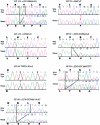De novo mutations in the sodium-channel gene SCN1A cause severe myoclonic epilepsy of infancy
- PMID: 11359211
- PMCID: PMC1226119
- DOI: 10.1086/320609
De novo mutations in the sodium-channel gene SCN1A cause severe myoclonic epilepsy of infancy
Abstract
Severe myoclonic epilepsy of infancy (SMEI) is a rare disorder that occurs in isolated patients. The disease is characterized by generalized tonic, clonic, and tonic-clonic seizures that are initially induced by fever and begin during the first year of life. Later, patients also manifest other seizure types, including absence, myoclonic, and simple and complex partial seizures. Psychomotor development stagnates around the second year of life. Missense mutations in the gene that codes for a neuronal voltage-gated sodium-channel alpha-subunit (SCN1A) were identified in families with generalized epilepsy with febrile seizures plus (GEFS+). GEFS+ is a mild type of epilepsy associated with febrile and afebrile seizures. Because both GEFS+ and SMEI involve fever-associated seizures, we screened seven unrelated patients with SMEI for mutations in SCN1A. We identified a mutation in each patient: four had frameshift mutations, one had a nonsense mutation, one had a splice-donor mutation, and one had a missense mutation. All mutations are de novo mutations and were not observed in 184 control chromosomes.
Figures



References
Electronic-Database Information
-
- Genbank, http://www.ncbi.nlm.nih.gov/Genbank (for genomic clone containing SCN1A [accession number AC010127], human SCN1A [for cDNA accession number AF225985, for protein accession number AAK00217], Rattus norvegicus Scn1a [accession number AAA79965], human SCN2A [accession number NP_066287], human SCN3A [accession number AAK00219], Rattus norvegicus Scn3a [accession number NP_037251], human SCN4A [accession number NP_000325], human SCN5A [accession number NP_000326], human SCN6A [accession number NP_002967], human SCN8A [for cDNA accession number XM_006838, for protein accession number XP_006838], human SCN9A [accession number NP_002968], human SCN10A [accession number NP_006505], human SCN11A [accession number AAF17480], human SCN12A [accession number NP_054858], Takifugu rubripes [accession number BAA07195], Loligo opalescens [accession number AAA16202], Electrophorus electricus [accession number CAA25587], Drosophila melanogaster [accession number AAB59192])
-
- Online Mendelian Inheritance in Man (OMIM), http://www.ncbi.nlm.nih.gov/Omim/ (for GEFS+ [MIM 604233]) - PubMed
-
- Primer3 program, http://www.genome.wi.mit.edu/cgi-bin/primer/primer3_www.cgi
-
- CEPH genotype database, http://www.cephb.fr/cephdb/dumps.html
References
-
- Akopian AN, Souslova V, England S, Okuse K, Ogata N, Ure J, Smith A, Kerr BJ, McMahon SB, Boyce S, Hill R, Stanfa LC, Dickenson AH, Wood JN (1999) The tetrodotoxin-resistant sodium channel SNS has a specialized function in pain pathways. Nat Neurosci 2:541–548 - PubMed
-
- Burgess DL, Kohrman DC, Galt J, Plummer NW, Jones JM, Spear B, Meisler MH (1995) Mutation of a new sodium channel gene, Scn8a, in the mouse mutant “motor endplate disease.” Nat Genet 10:461–465 - PubMed
-
- Commission on Classification and Terminology of the International League Against Epilepsy (1989) Proposal for revised classification of epilepsies and epileptic syndromes. Epilepsia 30:389–399 - PubMed
-
- den Dunnen JT, Antonarakis SE (2000) Mutation nomenclature extensions and suggestions to describe complex mutations: a discussion. Hum Mutat 15:7–12 - PubMed
MeSH terms
Substances
Associated data
- Actions
- Actions
- Actions
LinkOut - more resources
Full Text Sources
Other Literature Sources
Molecular Biology Databases

